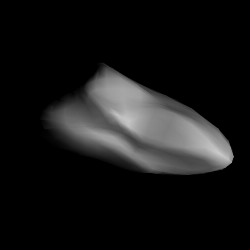 Shape model of Eger from its lightcurve | |
| Discovery | |
|---|---|
| Discovered by | M. Lovas |
| Discovery site | Piszkéstető |
| Discovery date | 20 January 1982 |
| Designations | |
| (3103) Eger | |
Named after | Eger |
| 1982 BB | |
| Orbital characteristics[1] | |
| Epoch 13 January 2016 (JD 2457400.5) | |
| Uncertainty parameter 0 | |
| Observation arc | 12495 days (34.21 yr) |
| Aphelion | 1.9021 AU (284.55 Gm) |
| Perihelion | 0.90673 AU (135.645 Gm) |
| 1.4044 AU (210.10 Gm) | |
| Eccentricity | 0.35437 |
| 1.66 yr (607.90 d) | |
| 208.62° | |
| 0° 35m 31.92s / day | |
| Inclination | 20.931° |
| 129.792° | |
| 254.007° | |
| Earth MOID | 0.0778981 AU (11.65339 Gm) |
| Proper orbital elements[1][2] | |
Proper eccentricity | 0.325 |
Proper inclination | 22.364° |
Proper mean motion | 99.460 deg / yr |
Proper orbital period | 3.61955 yr (1322.039 d) |
| Physical characteristics | |
| 1.5 km[1] | |
| 5.710156±0.000007 h[3] | |
| 0.64[1] | |
| E | |
| 15.38[1] | |
3103 Eger is an Apollo and Mars-crosser asteroid that was discovered in 1982, by Miklós Lovas. It was named after the city of Eger, Hungary. It has an albedo of 0.64,[1] making it a highly reflective asteroid.
- ^ a b c d e f "3103 Eger". JPL Small-Body Database. Jet Propulsion Laboratory. SPK-ID: 3103. Retrieved 14 April 2016.
- ^ "(162058) 1997AE12". NEODyS. University of Pisa. Retrieved 25 November 2015.
- ^ Cite error: The named reference
Durech-2012was invoked but never defined (see the help page).